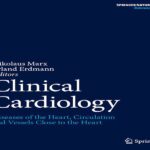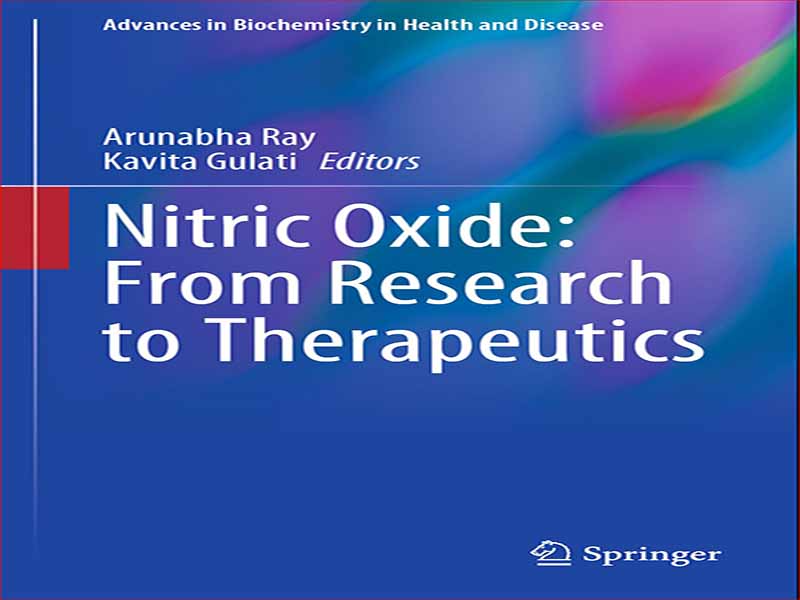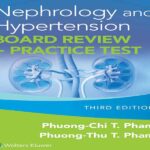- عنوان کتاب: Nitric Oxide: From Research to Therapeutics
- نویسنده: DiseaseArunabha Ray
- حوزه: فیزیولوژی
- سال انتشار: 2023
- تعداد صفحه: 469
- زبان اصلی: انگلیسی
- نوع فایل: pdf
- حجم فایل: 11.7 مگابایت
اکسید نیتریک (NO) یک مولکول سیگنال دهی در همه جا است که تقریباً در هر عملکرد سلولی و اندامی در بدن شرکت می کند. NO یک تاریخچه علمی جذاب و رنگارنگ دارد و تکامل آن از یک آلاینده زیست محیطی به یک جزء مواد منفجره (دینامیت) است و اکنون یک گازوترنسمیتر نتیجه چندین مشاهدات جالب است که در طول سه دهه انجام شده است. کشف NO به عنوان یک مولکول سیگنال در سیستم قلبی عروقی به گونه ای بود که سه دانشمند برجسته (رابرت فورشت، لوئیس ایگنارو و فرید مراد) به طور مشترک جایزه نوبل فیزیولوژی یا پزشکی را در سال 1998 برای “NO به عنوان یک مولکول سیگنال در سیستم قلبی عروقی.” از زمان کشف نقش NO در سیگنال دهی سلولی، NO به یکی از مولکول های مورد تحقیق در تاریخ اخیر تبدیل شده است. نزدیک به 100000 مقاله علمی در مورد NO و اثرات فیزیولوژیکی متنوع، اهمیت پاتوفیزیولوژیک و کاربردهای درمانی آن منتشر شده است. اکنون یک انجمن بینالمللی برای اکسید نیتریک برای ترویج فعالیتهای تحقیقاتی مرتبط با NO وجود دارد که مجلهای با عنوان نیتریک اکسید منتشر میکند. به زودی پس از شناسایی NO به عنوان یک مولکول سیگنال، گزارش شد که نیتریک اکسید سنتاز خاص (NOS) یک واکنش آنزیمی را کاتالیز می کند که منجر به تشکیل NO از سوبستراهای ال-آرژنین و اکسیژن مولکولی تحت شرایط بسیار تنظیم شده که نیاز به چندین کوفاکتور دارد. متعاقبا، یک مسیر جایگزین مستقل از NOS برای سنتز NO، بر اساس کاهش ساده نیترات و نیتریت، محصولات اصلی اکسیداسیون NO، کشف شد. در این دوره، علاقه به نقش بیولوژیکی NO منجر به انقلابی در تحقیقات دارویی و فیزیولوژیکی شده است. گزارش شده است که NO علاوه بر نقش کلیدی خود در تنظیم عملکرد قلبی عروقی، در فرآیندهای پاتولوژیک انواع بیماری های انسانی از جمله بیماری های متابولیک، بیماری های التهابی و ایمنی، سرطان و بیماری های عصبی- منطقی نقش دارد. با توجه به اهمیت NOS ها در پاتوفیزیولوژی بیماری های انسانی، این آنزیم ها اهداف درمانی بالقوه ای برای درمان آسیب شناسی های مختلف انسانی در نظر گرفته می شوند. دامنه مسیرهای سیگنال دهی NO و NO که در ابتدا به دلیل نقش تنظیمی خود در فیزیولوژی و پاتوفیزیولوژی قلبی عروقی شناخته می شد، اکنون به طور گسترده ای گسترش یافته است تا سیستم عصبی مرکزی (قابلیت سیناپسی، عملکرد شناختی، صرع، استرس و اضطراب، و غیره)، متابولیک را درگیر کند. اختلالات، بیماری های تنفسی، عفونت ها و آسیب شناسی ایمونولوژیک، مراقبت های ویژه و سرطان. برچسب گذاری NO به عنوان یک انتقال دهنده گاز (در کنار CO و H2S) همچنین یک بعد کاملاً جدید در زیست شناسی NO ایجاد کرده است. در خانواده انتقالدهندههای گاز درونزا، اکسید نیتریک (NO) کوچکترین پیامرسان بین سلولی گازی است که در تعدیل چندین فرآیند فیزیولوژیکی، مانند جریان خون و کنترل تجمع پلاکتها، که برای حفظ هموستاز عروقی ضروری است، دخیل است. علاوه بر این، نقشهای فیزیولوژیکی/اهمیت پاتوفیزیولوژیکی و تعاملات متداخل آنها انگیزه جدیدی به این زمینه داده است. نقشهای مختلف NO در حال حاضر از طریق مسیرهای سیگنال دهی متفاوت فعال میشوند. مسیر کلاسیک GC-cGMP توسط مسیرهای سیگنالینگ جایگزین که با آن ارتباطی ندارند تقویت شده است. اهداکنندگان NO مانند nitrosoglutathione، مواد مغذی آزاد کننده NO، نانوذرات NO استنشاقی، NO آزاد کننده و غیره، حوزههای هیجانانگیز تحقیقات NO ترجمهای معاصر هستند. بنابراین، NO به عنوان یک هدف مولکولی در حال ظهور برای توسعه استراتژیهای درمانی برای انواع بیماریها در نظر گرفته میشود که لزوماً محدود به سیستم قلبی عروقی نیستند. چندین ترکیب طبیعی مشتق شده، مانند پلی فنول ها، اکنون به عنوان تعدیل کننده مسیرهای NO پیشنهاد می شوند. هدف این کتاب با عنوان اکسید نیتریک: از تحقیق تا درمان، جمعآوری جامع برخی از جدیدترین اطلاعات در مورد نقش NO در فیزیولوژی، پاتوفیزیولوژی و ترجمه آن به درمانهای بالقوه است. این یک نشریه پیشرفته است که حاوی جدیدترین اطلاعات در مورد NO به عنوان یک تنظیم کننده فیزیولوژیکی و پتانسیل متنوع آن به عنوان یک هدف درمانی برای درمان بیماری های مختلف است که لزوماً محدود به سیستم قلبی عروقی نیستند. به طور خاص، تلاش شده است تا جدیدترین پیشرفتهای تحقیقاتی با NO و پیامدهای درمانی آن در انواع اختلالات قلبی عروقی، تنفسی، گوارشی، عصبی روانپزشکی، متابولیک و عفونی گنجانده شود. نقش آن در بارداری و موقعیت های مرتبط با جنین مانند پره اکلامپسی و تراتوژنز نیز مورد توجه ویژه قرار گرفته است. بخش ویژه ای از کتاب به نقش درمان های هدایت شده NO برای COVID-19، مخوف ترین بیماری همه گیر قرن می پردازد. سیستم های دارورسانی جدیدتر برای رساندن NO به اهداف درمانی نیز در این کتاب برجسته شده است.
Nitric oxide (NO) is a ubiquitous signaling molecule that participates in virtually in every cellular and organ function in the body. NO has a fascinating and colorful scien-tific history, and its evolution from being an environmental pollutant, to a compo-nent of explosives (dynamite), and now a gasotransmitter was an outcome of several interesting observations spanning across three decades. The discovery of NO as a signaling molecule in the cardiovascular system was such that three distinguished scientists (Robert Furchgott, Louis Ignarro, and Ferid Murad) were jointly awarded the Nobel Prize in Physiology or Medicine in 1998 for “NO as a signaling molecule in the cardiovascular system.” Since the discovery of NO’s role in cell signaling, NO has become one of the most researched molecules in recent history. Nearly 100,000 scientific articles have been published on NO and its diverse physiologic effects, pathophysiological significance, and therapeutic applications. There is now an Inter-national Society for Nitric Oxide to promote research activity relating to NO, which publishes a well-read journal entitled Nitric Oxide. Soon after the identification of NO as a signaling molecule, it was reported that specific nitric oxide synthase (NOS) catalyzes an enzymatic reaction leading to NO formation from the substrates L-arginine and molecular oxygen under highly regulated conditions requiring several cofactors. Subsequently, an alternative NOS-independent pathway of NO synthesis was discovered, based on the simple reduction of nitrate and nitrite, the main oxida-tion products of NO. During this period, interest in the biological role of NO has led to a revolution in pharmacological and physiological research. In addition to its key role in regulating the cardiovascular function, NO has been reported to be involved in the pathological processes of a variety of human diseases, including, metabolic diseases, inflammatory and immunological diseases, cancer, and neuro-logical diseases. Given the importance of NOSs in the pathophysiology of human diseases, these enzymes are considered potential therapeutic targets for the treatment of diverse human pathologies. Originally known for its regulatory role in cardiovas-cular physiology and pathophysiology, the domain of NO and NO signaling pathways have now vastly expanded to involve the central nervous system (synaptic plasticity, cognitive function, epilepsy, stress and anxiety, etc.), metabolic disorders, respi-ratory disease, infections and immunological pathology, critical care, and cancer. The labeling of NO as a gasotransmitter (alongside CO and H2S) has also opened up a completely new dimension in NO biology. Within the family of endogenous gasotransmitters, nitric oxide (NO) is the smallest gaseous intercellular messenger involved in the modulation of several physiological processes, such as blood flow and platelet aggregation control, essential to maintain vascular homeostasis. Further, their overlapping physiological roles/pathophysiological significance and interac-tions have given a new impetus to this field. Different roles of NO are now being advo-cated operating via distinctly varied signaling pathways. The classical GC-cGMP pathway has been reinforced by alternative signaling pathways which are unrelated to it. NO donors like nitrosoglutathione, NO-releasing nutraceuticals, inhaled NO, NO-releasing nanoparticles, etc., are exciting areas of contemporary translational NO research. Thus, NO is considered as an emerging molecular target for developing therapeutic strategies for a variety of disease states not necessarily restricted to the cardiovascular system. Several naturally derived compounds, such as polyphenols, are now proposed as modulators of NO-mediated pathways.
This book entitled Nitric Oxide: From Research to Therapeutics aims to compre-hensively collate some of the most recent information about the role of NO in physiology, pathophysiology, and its translation to potential therapeutics. It is a state-of-the-art publication containing the most recent information on NO as a physiological regulator and its diverse potential as a therapeutic target for the treat-ment of various diseases, which are not necessarily restricted to the cardiovascular system. Specifically, an attempt has been made to include the most recent research developments with NO and its therapeutic implications in a variety of cardiovascular, respiratory, gastrointestinal, neuropsychiatric, metabolic, and infectious disorders. Its role in pregnancy and fetus-related situations like pre-eclampsia and teratogenesis has also received special attention. A special section of the book deals with the role of NO directed therapeutics for COVID-19, the most dreaded pandemic of the century. Newer drug delivery systems for delivering NO to therapeutic targets are also highlighted in this book.
این کتاب را میتوانید از لینک زیر بصورت رایگان دانلود کنید:



































نظرات کاربران